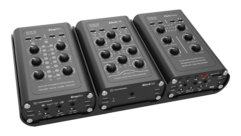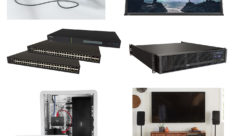

Inside the Pro AV Channel
The sales channel for professional AV products is as vast and varied as the companies within it.
The sales channel for professional AV products is as vast and varied as the companies within it. Each player–from manufacturer and distributor to sales rep, consultant, and integrator–cannot function without the other, yet their distinct needs and wants are what make the channel so complex. And even before the recent economic downturn, there were unique challenges facing each segment of the channel.
As a senior consultant with Cavanaugh Tocci Associates, Mike Maynard has seen the time from spec and drawing to bid shrink, while the projects remain just as complex.
Credit: Bryce Vickmark/WPN
North America, according to figures from InfoComm. Its 2008 Market Forecast Survey also indicates that the AV market is growing at a rapid pace, with 40 percent of companies planning to expand their focus with new technologies. Staffing plans are also robust, with just under 60 percent planning to hire more tech staff and over half of companies investing in additional training.
But no one that Pro AV spoke to throughout the channel is blind to the economic realities that could test it. Manufacturers are hungry for sales forecasts from their reps; distributors are giving ROI pointers to help sales; and reps are hearing about delayed projects from customers. “AV demand is still high, but payments are getting delayed longer and longer,” says Matthew Sittloh, a Midwest-based manufacturer’s representative. “The dealers who have good credit and took advantage of quick pays are the ones who are doing well right now.”
Andrew Sellers of integrator Sensory Technologies says, “This year, we’ll see business failures at all levels. We’re already seeing some things that may drive prices up and drive a change in payment terms.”
But everyone agrees, if the channel can pull together to help one another, the industry will weather the storm. And as the AV market gets back to expansion, it’s important to understand the viewpoints of those channel partners who make that expansion possible.
Integrators & Dealers
Selling Concepts, Not Commodities
The biggest hurdle facing integrators over the past decade has been the commoditization of certain AV products. The positive effect has been increased awareness of AV and the technologies that drive the industry. The negative has been that integrators have needed to reformulate what it means to stay successful.
“What many manufacturers now sell is geared towards the end-user market versus the commercial market. Think flat panels and projectors,” says Sellers, CTS, co-owner and principal at Sensory Technologies. “It changes the delivery method, which is why you see more distributors interacting with dealers.”
In addition to commoditization, says Dawn Meade, CTS, director of marketing and AV sales for Advanced Video Systems, “The influx of IT and computer companies into our market, and the ‘everyone’s an expert’ mentality drives up expectations and drives down the perceived value of what a system should cost.”
Technology lifecycles also put pressure on integrators to keep informed of new trends. “I’ve been in the industry for 12 years and have personally witnessed the end of three-gun projectors, the rise of LCD/DLP projectors, their rapid shrinkage in size and price, the rise of the plasma display, and then the rise of the LCD display,” says Meade. “Now we hear ‘plasma is dead,’ and few, apart from road warriors, bother with projectors when nice crisp flat panels work just as well in the end-users’ view.”
Sellers says he uses a consultative sales model whereby Sensory does not give out an equipment list. “We do provide a functional description but we do not give away the recipe. When a potential customer asks why, that leads into a discussion about value and intellectual property,” he says. “We are selling concepts and solutions first; not just products.”
Sensory has gone a step further and has made significant infrastructure investments in engineering and sophisticated project management. “Our process-driven approach is vital to success. We feel that a specialist is required at each step of the project process,” says Sellers.
In the face of increased competition and product commoditization, Sellers laments the end of exclusivity for dealers. “What I often ask for from a manufacturer is a way to protect our sales in the market; especially a design/build that may turn into a competitive situation, i.e., a price war,” he says. “For example, I’ll ask a manufacturer for an exclusive offer. The easy thing is price discounts so there’s a better chance of winning the deal, but other strategies are extended warranty, training, or buy one quantity and get a free quantity.”
Consultants
Designing with Less Time
AV consultants work on AV designs that may not become a reality for several years. “By the time an integrator sees the bid package, the consultants have been living with the design for years. Things may have been value-engineered out,” says Michael Shafer, senior consultant in The Sextant Group’s Phoenix office. “The package you have in your hands is the best possible solution after this months-long process.”
Shafer has been in the AV industry for 25 years, most of that time as a consultant. “When I first started as a consultant, customer needs and equipment choices were simpler but changes in the form factor happened quickly. My job is to work with architects to create the space, made more difficult because the forms were very volatile.”
Today, the volatile equation is time. “It used to be unusual to ‘fast track’ a project, but now it seems like all of them are on a fast track,” Shafer adds.
Mike Maynard, senior consultant with Cavanaugh Tocci Associates, agrees, “Project time lines are shorter but the amount of work is the same due to complex AV systems. The biggest challenge is time compression. The time period from specs and drawing to bid for a medium-sized performing arts center used to be one-and-a-half years, but now it is less than a year.”
As a result, Maynard says, “You have to become sharper with coordination between systems because you are designing more systems in less time. There is no such thing as ‘fix it in the mix’ anymore.”
Shafer thinks that the rapidly changing costs of building materials are driving the time crunch. “The faster the building can come together, the better for the owner,” he says.
Shafer says one of the things that would make his job easier is if manufacturers understood that a consultant’s role on a project requires different information or faster response. “For example, long-term projects from programming to final commission can be three years. We work with architects who need to know what they need to design to hide AV that doesn’t exist yet,” he explains. “Some manufacturers will sign confidentiality agreements and will tell us about product development and what we can expect in the coming years.”
Inside the Pro AV Channel
The sales channel for professional AV products is as vast and varied as the companies within it.
Manufacturer’s Reps
Fielding Demands for Discounts and Deals
A manufacturer’s sales representative is the boots on the ground for nearly every manufacturer. A rep’s job is spent on the road, visiting his manufacturers or his dealer/integrators and distributors.
“We conduct product demos and give literature, but today it has to be more technical. You have to have more knowledge to bridge the gap between networking and AV,” says Sittloh, a former contractor and current rep who covers Indiana, Kentucky, and Illinois for Visitec Marketing. “A laptop and a bag of literature don’t cut it anymore.”
Matthew Sittloh, manufacturer’s rep for Visitec Marketing (left), spends quality time with Andrew Sellers, co-owner of integrator Sensory Technologies.
Credit: AJ Mast/WPN
Alan Geer, president of rep firm Audio Geer, says, “We do a lot more than we used to. These days, there is much more time spent planning and coordinating with the manufacturer. They’re are demanding more time and attention to detail from most representatives.”
Which can translate into an all-out time crunch for reps. “With many integrators, it is easier for them to just call you to find out an answer,” says Sittloh. “There are some days when I get over 40 phone calls and barely have time to listen to the messages between meetings.”
To assist with customer support, Visitec has invested in insides sales experts for the Lutron and Liberty Wire brands it represents. It has also added in-house tech support for when a rep is not immediately available.
In addition to the time crunch, Sittloh says the politics of the job are particularly challenging.
“I am always asked by my dealers to get them a discount or a deal–something that sets them apart. It’s especially difficult when more than one of my dealers is on the same project,” he says. “I try to teach them to sell more than just on price; to not undercut each other and focus on streamlining processes and efficiencies.”
But often, if the rep doesn’t focus on the streamlining, it doesn’t get done.
“Reps exist because of the gap in service, support, and communication between resellers and manufacturers,” says Geer. “If that gap gets smaller, then the business gets easier–which means one step closer to the door for every rep across the country.
“One benefit that this tough economy has brought to reps is that manufacturers and resellers alike are doing more work with less people than ever,” Geer adds. “As long as that remains the case, complication will exist and my role between the two parties will continue to solidify.”
Distributors
Creating the Market, Building the Brand
Distributors, or third-party resellers, play a unique but vital role in the sales channel. They are often the importer and sole market representative in the U.S. for overseas brands. Jack Kelly, president of pro audio distributor GroupOne, says the majority of his business operates on this model. “The process of distribution has not changed in the 33 years I’ve been in the business,” he says. “We buy and inventory the products, and create the marketplace and the demand. In short, we act in the best interest of the manufacturer.”
Kelly notes that the key to a successful distributorship is the manufacturer offering the right product and price at the right time. “In pro audio distribution, specifically, it can be hard to make a living. You need a bare minimum number of people–sales, service, shipping personnel–and overhead can easily be $500,000. You need to pull a few million to cover it.”
The core of GroupOne’s success has been relevant products, as well as long-term relationships with their manufacturers. Kelly has worked with U.K.-based companies XTA for 16 years and with Pulsar for 37 years. “Having that relationship brings a degree of credibility when discussing the market,” Kelly says.
Tom Bensen, who manages the U.S. operations for Italian brands Powersoft and Outline, says his job is about looking at what is the more effective distribution method and building the brand in the U.S. “Our job is information processing and information distribution. The first thing you do is provide education, especially for new brands, about the best way to utilize our products. If people have to think about it, then I am not doing my job.”
Jim Ritchhart, general manager of BAI Distributors, represents over 100 foreign and domestic brands and sells directly to contractors and dealers. He agrees that the business of distribution has not changed, with the exception of the product mix brought on by customer requests. “People were asking for more CCTV and AV products, rather than just audio,” he says.
To better manage his time, Ritchhart doesn’t attend business lunches, even when invited by his sales rep. “We would rather focus the time on customer service to our customers,” he says. “If a rep or manufacturer has something important to tell me, send me an e-mail.”
Ritchhart also notes that, while manufacturers and distributors may be cutting back, his firm is not cutting the budget for trade show attendance or training in 2009. “We will have a presence at InfoComm, for example. You still have to let customers know you are supporting them,” he adds.
Inside the Pro AV Channel
The sales channel for professional AV products is as vast and varied as the companies within it.
Manufacturers
Staying Close, Offering More Tools
For many manufacturers, past success was simply about providing the best technology and products. Jay Dellostretto, vice president of sales for Sony Electronics’ Broadcast and Production Systems Division, points out that we are no longer doing business in simple times. “In the past, it was about winning the format war. Today, there are many formats and increased competition as well as new applications. We need to provide resellers with even more reasons to support Sony–like direct touch (sales support, training, and planning) and programs that drives sales and more profit opportunities.”
Integrators provide essential field testing for manufacturers, says Dawn Meade of Advanced Video Systems, which passes along information about bugs.
Credit: Bruce Weller
Alan Stoddard, vice president of U.S. sales for AMX, adds, “The huge number of players that can influence the sale are what challenges us the most. Every person involved is savvy and opinionated, making the channel very complex and dynamic. For us, it’s about becoming more cognizant of interactions and building an integrated sales team that reflects each part of the channel.”
Sony employs a multimarket channel strategy that includes direct sales, resellers, integrators, and third- party resellers via distribution. Dellostretto says that training the channel about new product models is a challenge due to the rapid pace of development. “It used to be about features and benefits but that’s only part of the story. Now, we field questions about efficiency and how our products fit into a workflow,” he explains.
Similarly, there is channel demand for AMX to improve their tools and training.
“It is all about knowledge and training at the moment,” says Stoddard. “It is hard for sales reps to slow down and get the knowledge they need. As a result, we are looking at alternative training methods to eliminate the need to gather salespeople in the same room. We are putting more emphasis into courses, certifications, and helping with sales implementation.”
Stoddard says that emphasis is needed because integrators and end-users are dealing with complex issues such as networking and device interactions. “AMX provides knowledge topics on how to work with a large network, a wireless implementation, and complications or prioritization issues,” he says. “These are relatively complex problems that require a level of proficiency and skill needed to use our products.”
Sony has made efforts to improve the resources, programs, and tools it offers the channel, as well as deliver more efficient communications and education. “The biggest change is in our execution, for example, using the Internet to handle messaging, order management, training, and pricing,” says Dellostretto.
In January, Sony held its first virtual trade show for resellers and customers that provided presentations, live chat rooms, and online product demos. “We still believe in direct touch, but we align the approach based on product strategy and customer needs,” he adds. “In this economy, we have to stay close to our customers and help drive their business more efficiently. We have to listen and have the courage to change.”
Linda Seid Frembes is a Pro AV contributing editor.










